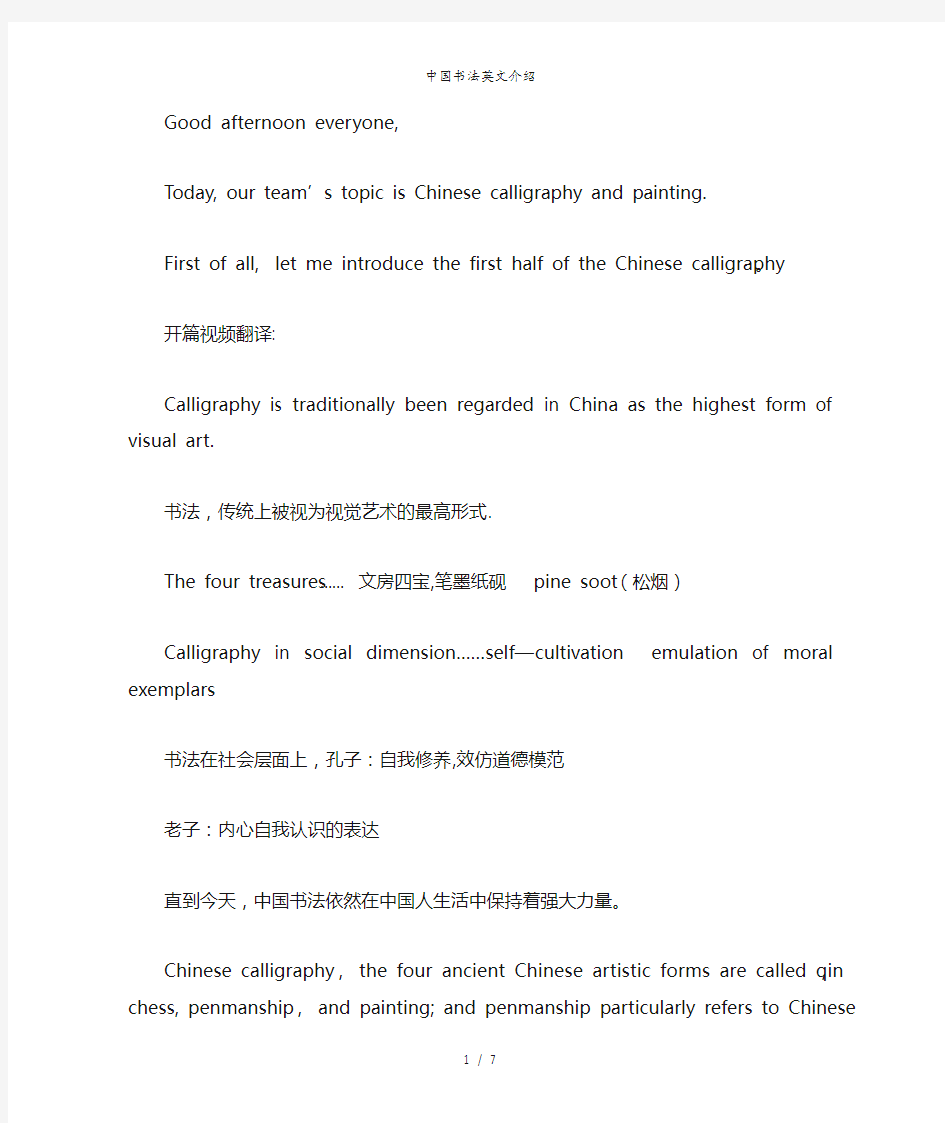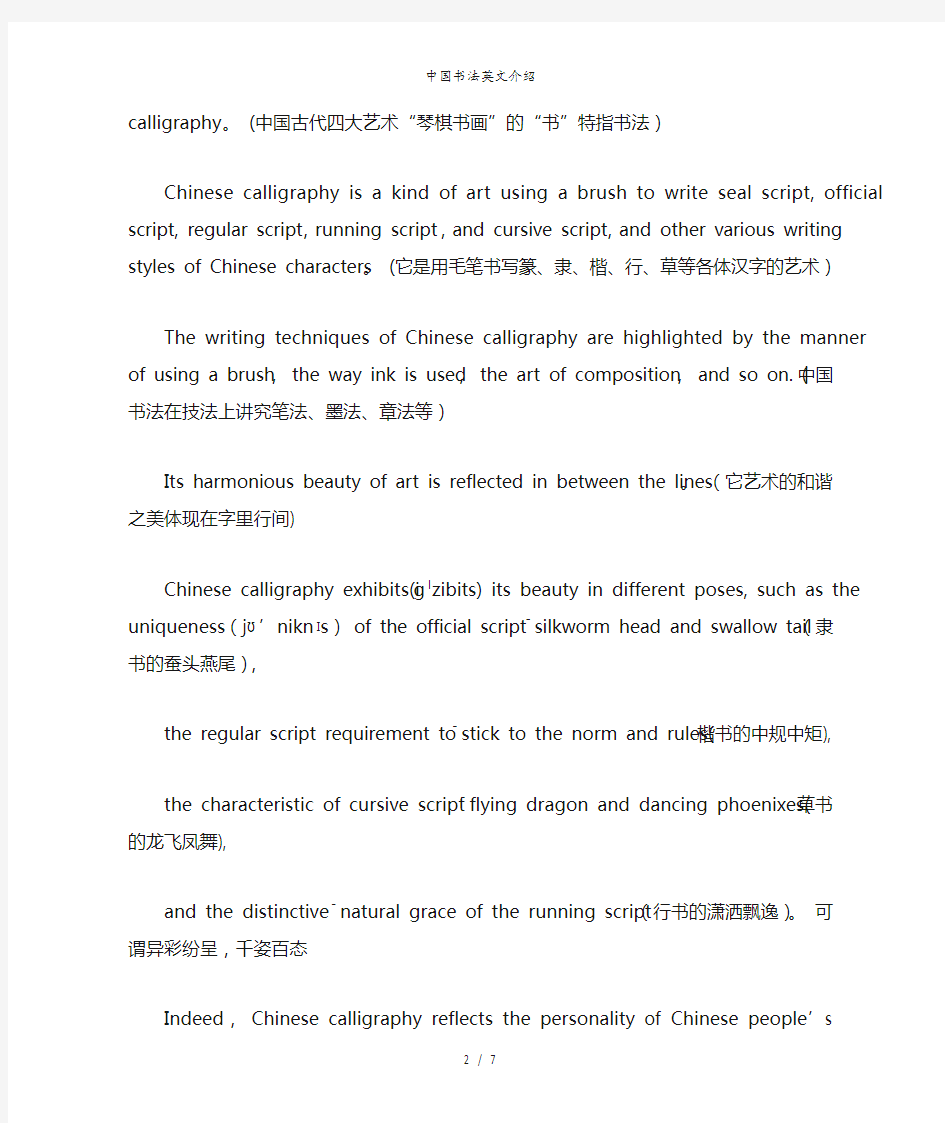

Good afternoon everyone,
Today, our team’s topic is Chinese calligraphy and painting.
First of all, let me introduce the first half of the Chinese calligraphy。开篇视频翻译:
Calligraphy is traditionally been regarded in China as the highest form of visual art.
书法,传统上被视为视觉艺术的最高形式.
The four treasures……文房四宝,笔墨纸砚 pine soot(松烟)
Calligraphy in social dimension……self—cultivation emulation of moral exemplars 书法在社会层面上,孔子:自我修养,效仿道德模范
老子:内心自我认识的表达
直到今天,中国书法依然在中国人生活中保持着强大力量。
Chinese calligraphy, the four ancient Chinese artistic forms are called qin,chess, penmanship, and painting; and penmanship particularly refers to Chinese calligraphy。 (中国古代四大艺术“琴棋书画”的“书”特指书法)
Chinese calligraphy is a kind of art using a brush to write seal script, official script, regular script, running script, and cursive script, and other various writing styles of Chinese characters。 (它是用毛笔书写篆、隶、楷、行、草等各体汉字的艺术)
The writing techniques of Chinese calligraphy are highlighted by the manner of using a brush, the way ink is used, the art of composition, and so on. (中国书法在技法上讲究笔法、墨法、章法等)
Its harmonious beauty of art is reflected in between the lines。(它艺术的和谐之美体现在字里行间)
Chinese calligraphy exhibits(iɡ?zibits) its beauty in different poses, such as the uniqueness(j?’nikn?s) of the official script ―silkworm head and swallow tail (隶书的蚕头燕尾),
the regular script requirement to ―stick to the norm and rules(楷书的中规中矩), the characteristic of cursive script ―flying dragon and dancing phoenixes(草书的龙飞凤舞),
and the distinctive ―natural grace of the running script(行书的潇洒飘逸)。可谓异彩纷呈,千姿百态
Indeed,Chinese calligraphy reflects the personality of Chinese people’s straightforwardness, dignity, and reticence('ret?sns).(中国书法体现了中华民族的豪爽大气、端庄含蓄的特点)
Chinese characters were initially meant to be simple pictures use to help people remember things。 After a long period of development, it finally became a unique character system that embodies phonetic sound, image, idea, and rhyme(ra?m)at the same time.(汉字是从原始人用以记事的简单图画,经过不断演变发展最终成为一种兼具音、形、意、韵的独特文字)
The writing system, which was extremely advanced in ancient times, began with inscriptions on bones and tortoise shells, and these are regarded as the original forms of Chinese characters. (现存中国古代最早成熟的文字是甲骨文,被认为是现代汉字的初形)
Afterwards, Chinese characters went through numerous calligraphic styles:bronze inscriptions, official script, regular script, cursive script, running script, etc。(此后,汉字又经历了金文、隶书、楷书、草书、行书等不同的阶段) Chinese characters are usually round outside and square inside, which is rooted in ancient Chinese beliefs of an orbicularsky and a rectangular Earth。 (汉字结构“内圆外方",源于古人“天圆地方”的观念)
The five basic strokes of Chinese characters are 一 (the horizontal stroke), 丨 (the vertical stroke), 丿(the left-falling stroke),捺(the right—falling stroke), and 乙 (the turning stroke). (汉字有五种基本笔画,即:横、竖、撇、捺、折)
The four treasures of the study。文房四宝
The writing brush, ink stick, ink stone, and paper were requisite('rekw?z?t) treasures in the study of the scholars of ancient China, and they are often referred to as the ―Four Treasures of the Study。(笔墨纸砚是中国古代文人书房当中必备的宝贝,被称为“文房四宝”)
The writing brush and ink stick have been used by the Chinese to write and paint since 5,000 years ago。(用笔墨书写绘画在中国可追溯到五千年前)
In the Qin Dynasty (221BC—206BC), people already used feathers(’f?e?)of different hardness and bamboo trunks to make brushes。(秦朝时已用不同硬度的毛和竹管制笔)
During the Han Dynasty (206BC—220AD), man-made ink was used instead of natural ink. (汉代以人工制墨替代了天然墨)
After paper was invented by the Chinese, bamboo slips, wooden tablets, brocade and silk, which originally functioned as writing surfaces, gradually faded out。(有了纸张以后,简牍锦帛逐失其用)
The ink stone was first developed with the use of writing brushes and ink. (砚台则随笔墨的使用而发展)
After the Song Dynasty(960AD-1279AD), the ―Four Treasures of the Study,particularly referred to hubi, the writing brush produced in Huzhou, Zhejiang province; huimo, the instick produced in Huizhou, Anhui province; xuan paper,a kind of paper produced in Xuanzhou, Anhui province; and duanyan, the ink stone made in Zhaoqing, Guangdong province(Zhaoqing was earlier called Duanzhou).
Indeed, the ―Four Treasures of the Study have written the whole Chinese civilization, as it is。
“文房四宝"到宋朝(960—1279)以后特指湖笔(浙江湖州)、徽墨(安徽徽州)、宣纸(安徽宣州)、端砚(广东肇庆,古称端州).可以说文房四宝书写了整个中华文明。
Wang Xizhi ( 303-361) was a Chinese calligrapher。 He is considered by some as the first "artist” in the Western sense, insofar as it has moved away from the official canon['k?n?n] in force, the cursive handwriting, practicing a form of free personal and pictorial practice。
王羲之是中国的书法家,他在西方被认为是第一位艺术家,他摆脱官方的标准,创造了独具自身自由特色的形象化的草书.
Yan Zhenqing is a master of calligraphy in Tang Dynasty。 (颜真卿是唐代书法大师)
His innovation in calligraphic expression is influenced by his engagement with the northern tradition of monumental standard script styles representing a balance betwee n propriety and Zhang Xu’s wildness. (他的书法创新表达是基于他北部传统风格和张旭的野性适当平衡中和表现的)
The sheer weight and lack of hesitation in his brushstrokes has long been associated with his physical and moral courage. (俊俏毫不犹豫的笔锋一直和人的身体和思想联系在一起)
A master though, he was not a professional himself。 Instead, he was also well—known for being a straight-forward official for the government in his time。(尽管是一位大师,但是他的主业不仅限于书法。相反,他也是直言进谏的官员而闻名于他的那个年代.)
柳公权(778-865)—Tang dynasty
?Liu Gongquan, a master of kaishu and cursive(行草) who is oftened mentioned with Yan Zhenqing. (柳公权,楷书和行草大师,和颜真卿并称为“颜筋柳骨”) Kaishu: vigorous and rigorous 楷书骨力遒健
Running-cursive: fluent and flowing 行草行云流水
黄庭坚(1045—1105) Huang Tingjian
? A calligrapher and poet in Song dynasty. ?His works are fancy and firm, leading change of the trend。
Popular styles
黄庭坚是北宋的书法家和诗人.他的作品奇绝坚实。是当时流行的形式。
Calligraphy is considered the most important art in East Asia, and also the most elegant form of writing. 书法被认为是东亚的重要艺术和最优雅的写字形式。
Write Chinese characters well, has always been a kind of accomplishment. 写好汉字,历来都是一种素养.
Calligraphy, originated in China, and is respected by the East Asian civilizations。 Many countries practice the Chinese calligraphy。 It promotes the development of cultural communication。书法源自中国,受东亚文明社会敬重并被广泛实践,促进了文化交流发展。